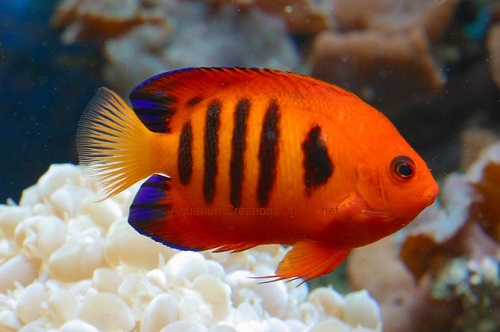| Common Name |
Flame Angelfish
|
| Scientific Name |
Centropyge loricula |
| Origin |
Christmas Island, Cook Islands, Tahiti
|
| Max Size |
6 inches |
| Reef Safe |
With Caution |
| Min Tank Size |
70 gallons |
| Diet |
Omnivore |
| Care Level |
Beginner |
| Temperament |
Semi-Aggressive |
Identification:
The Flame Angelfish (Centropyge loriculus) is one of the most popular dwarf angels for saltwater aquarium hobbyists. With its flaming red/orange color, its vertical black stripes on the body, and dorsal and anal fins with blue accents what can you say, its a beautiful fish. Other common names include flame angel, flaming angelfish and Japanese pygmy angelfish. Besides its sheer beauty, it is a great choice for home aquariums because it only grows to roughly 4 inches, and adapts well to aquarium life. To thrive we suggest all dwarf angels require a mature tank that is a minimum of 70 gallons with plenty of live rock and algae growth. If you are considering keeping multiple dwarf angels in your saltwater tank we suggest a tank size of no less than 100 gallons or more. This will lower the stress level in the tank and they will not feel they have to fight for their space. Place the rock work with multiple places to hide so they will feel secure enough to come out often. This will provide security, and the more secure it feels, the more it will come out into the open.
The flame angel normally will be shy upon introduction to an established aquarium, especially smaller specimens; but within a week, it will gain confidence and is then constantly seen grazing around live rock during the day. Often considered reef safe, they will adapt to a captive diet quickly, and if fed often enough, will usually prevent them from consuming your live coral and clams. Individual specimens that do pick at coral or clam mantles are more often than not under fed or under nourished. The trick to keeping any Dwarf or full size angel with corals and invertebrates, is to keep your fish fed very well! A happily fed Flame Angel or any dwarf angel the food they love will cut down on their need to graze on corals and invertebrates.
Flame angels have slight differences in their coloration and in the markings depending on where they were collected from. Flame angelfish collected in the Christmas Islands have a color that is red/orange and they have thin black vertical bars on the body. Those collected from the Marshall Islands have more red (less orange) in their body color and the vertical black bars that run up and down on their body are thicker than the Christmas Island Flame Angelfish. The flame angelfish coming out of the waters near Cebu are red/orange with the same vertical black bars on the body except they have a tint of yellow between the bars. Last there are flame angels collected from Tahiti that are deep blood red in color and have either very little yellow or no yellow between the bars. Now these descriptions are just a general guidelines and expect to see differences in all the location descriptions. Price differences in the different collection areas come from transportation and shipping expenses.
Food and Diet:
Dwarf Angelfish are omnivore's. In the wild it feeds primarily on algae, but it will also ingest tiny animals living in the algae. In captivity their diet will be mostly algae, but also offer some other proteins. Feeding them a variety of good foods is important. Offer various types of fresh and dried marine algae, spirulina enriched foods, mysis shrimp, shaved shrimp and other high-quality meaty foods, angelfish preparations, and flakes or pellets designed for algae eating fish. There are several good commercial foods available including Formula II and Angel Formula. Feed several times a day even if natural foods are present.
Level of Care:
Beginner
Aggressiveness:
Semi-aggressive
Recomended amount of drip acclimation time:
3+ hours
Reef Compatibility:
With Caution
Approximate Purchase Size:
Small: 1" to 1-1/2"; Medium: 1-1/2" to 2-1/2"; Large: 2-1/2" to 4"
|
Copyright 2020 Aquarium Creations Online
Photos are representative of each species. All marine life will be unique and variations should be expected, color and sizes may vary.
|
|



